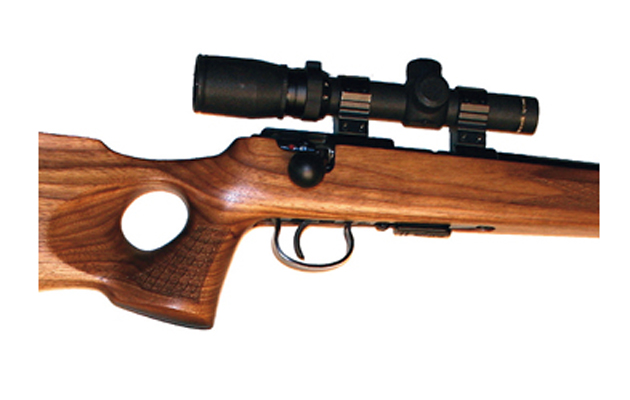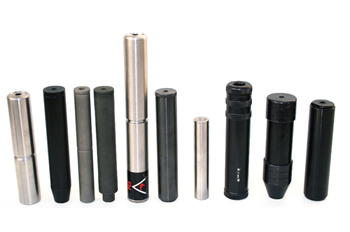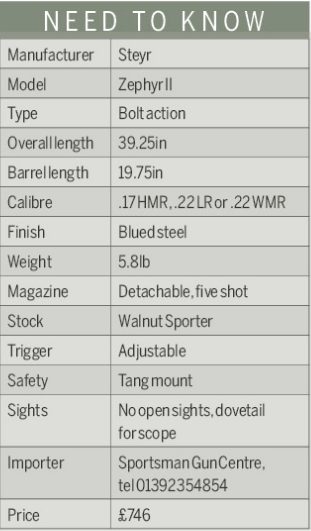This review pits the Sako Quad Synthetic, CZ Synthetic Silhouette, Browing T-Bolt Synthetic and Anschutz 1517 Thumbhole against each other…
Win CENS ProFlex DX5 earplugs worth £1,149 – enter here
Steyr Zephyr II .17 HMR rimfire

The original Steyr Zephyr was a .22 LR, produced in 1966 by Steyr Mannlicher, and it was unlike any other rimfire available at the time. It had that everlasting and alluring quality that Steyr rifles possess and it was the only rimfire I knew of that had a Stutzen — or full-length — stock. These are rare now and highly desirable.
Steyr has now revived the Zephyr rimfire, with a few changes. The Stutzen stock has gone, but this Sporter version looks very nice. The same barley-twist barrel profile remains, as does the well-engineered action design, and it is now available in .17 HMR, .22 LR and .22 WMR.
Retailing at £746, the Zephyr II, with its modern and Teutonic design, is a breath of fresh air in the rimfire market.
The Zephyr II’s styling is a blend of traditional bolt-action rimfire and more modern- day flair. It is light at 5.8lb, which adds to the appeal. This, combined with a 14.25in length of pull, makes for good handling and a balanced and effortless grip.

The Zephyr II has a barley-twist barrel profile, 100 per cent reliable bolt action and familiar magazine system
Visual appeal
- The stock is walnut and has a nice semi-rubbed oil finish, which gives a practical as well as visual appeal. The walnut is light in colour, which suits this rifle, and the grain and figure are good enough to draw interest, but it is the styling that catches the eye. The wood is well scalloped to form finger holds, rests and interesting curves that give the Zephyr definite flowing lines.
- The pistol grip is particularly well formed, having a long rake to it for effortless hold, and the trigger-blade is 3in from the front of the grip. It has a palm swell to the right and, as with the fore-end, possesses good laser-cut fish-scale chequering that grips well and looks classy. There is also a soft rubber recoil pad and swivel studs that, when tested, would only fit Steyr’s own loops.
- The cheekpiece is typically German, a Bavarian double-line affair that flows back over the top of the pistol grip to the belly of the stock, forming a lip and good finger hold in the fore-end that terminates in a Schnabel tip. This all adds up to a handsome, great-handling stock, whichever way you look at it.
- The action is marked ZR II and has a long bolt release and 11mm dovetails to fit a scope direct to the action top. Typically, Steyr utilises the traditional butter-knife bolt handle with a low travel and height. This is chromed for a slick operation and has twin extractor claws and a spur-type ejector that was 100 per cent reliable in the tests.
- The trigger was gold anodised and had a long first travel then a small creep to second release of 3.85lb. It can be adjusted, but I left it and soon got used to it.
- The safety is a tang type, which I like. The forward position shows a red dot, indicating the rifle is ready to fire, while the back position shows white, meaning it is safe.
- The floor-plate and magazine system come straight from a CZ rifle. These are tried-and-tested parts and, as an added bonus, spare magazines are cheap too. The Zephyr comes with a five-shot magazine as standard.
- The barrel is very well made, with the Steyr barley-twist barrel profile, and has the same matt-blued finish as the action. It is fully floated from the fore-end wood, comes screw cut with a ½in UNF thread and is 19.75in long.
- The internal finish to the rifling was excellent.
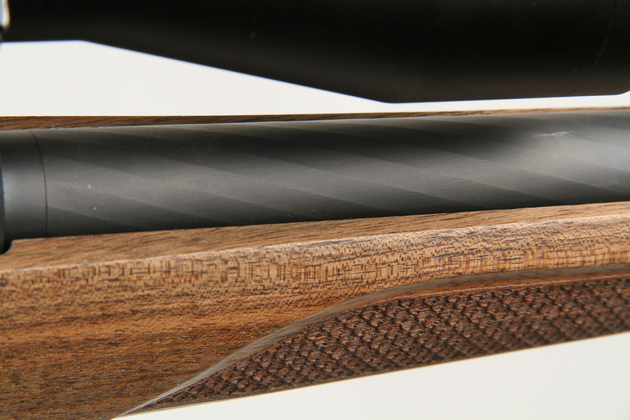
Walnut stock
To the bench
There are no reloads for the .17 HMR, so I tried a selection of factory brands in differing weights to find out what the Zephyr liked. The typical bullet weight is 17-gr and there are many to choose from, as well as the heavier 20-gr and lighter, lead-free 15.5-gr. Off the bench, the Zephyr shot really well — no real surprise with that hammer-forged hammer and precision rifling. With regard to accuracy, at 50 yards the five-shot groups were tiny. All the ammunition, regardless of weight, shot less than 0.75in — and some as small as 0.45in.
The Hornady 17-gr V-Max load is the industry-standard HMR — it started the .17 HMR pedigree after all. With a consistent 2,578fps for 251ft/lb, it shot amazing 0.35in 50-yard groups and 0.75in 100-yarders.
I like the heavier bullet and stronger construction of the CCI Game Point 20-gr. Good for foxes, this round is accurate too, with 0.45in 50-yard groups, a velocity of 2,427fps for 262ft/lb energy and good expansion from the hollowpoint design.
The Hornady NTX is the lead-free option and as such uses a lighter bullet at 15.5-gr due to its sintered bullet design. It is always accurate and in the Steyr it shot 0.50in 50-yard groups for 2,571fps and 228ft/lb energy.
Remington’s 17-gr AccuTip load too was dead on, with 0.55in groups and a healthy velocity of 2,566fps for 249ft/lb energy. So, depending on the quarry you wish to hunt, there is an accurate round tested here for you.
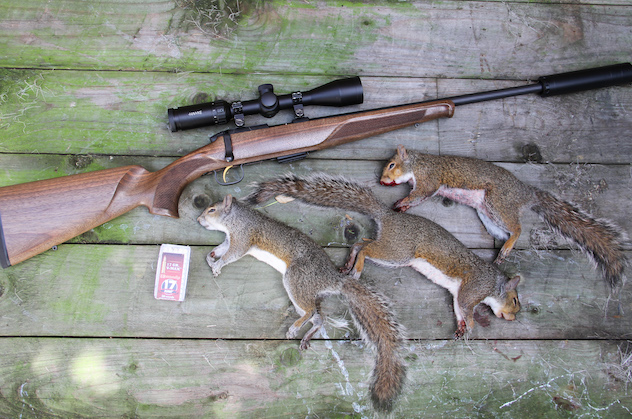
Take the Zephyr, add a Hawke scope, Wildcat moderator and Hornady ammo and you have a superb vermin tool.
In the field
Befitting a Sporting arm designed for field use, I used a Wildcat Panther sound moderator. Its over-barrel design ensures that the weight — just 220g thanks to its aluminium construction — is well distributed and thus handling is not compromised. It also means the overall length is only 112mm in front of the barrel. And, of course, it is very effective for sound suppression.
I zeroed the Hawke Vantage scope at 0.5in high at 50 yards, so the trajectory was set as flat as possible — little adjustment for elevation was needed at any practical range to 125 yards. It pays to take a bit of time sighting in correctly and practising at varying ranges so you feel confident on live game in the field.
Usually the HMR’s duties entail a spot of rabbiting or fox control, but I had other ideas for the Zephyr II as a farmer was complaining of grey squirrels eating through grain sacks in his barn. Squirrels can be tough little critters to nail to the spot and the Zephyr II in .17 HMR would give me the accuracy I needed, as well as fast expansion, limiting the chance of ricochets.
In the high seat
With squirrels in barns, elevated shots are a no-no due to the bullet’s over-travel, so I chose to set up a folding high seat between the barn and the squirrels’ wooded home. It was seriously hot and uncomfortable, but it wasn’t long before I heard the telltale scurry of a squirrel down the blind side of the trees and then the quick scamper to the barn. But they weren’t stopping — and I can’t blame them.
To get the chance of a shot, I clenched my teeth and mimicked squirrel chatter with my tongue. This worked well for three out of five squirrels that fell to the Hornady 17-gr V-Max rounds; the trouble was, a sixth squirrel decided to use my tree as his barn run and so after a face-off and alarm call, that was that.
.17HMR calibre sound moderators review
.17HMR calibre sound moderators: .17HMR sound moderators are increasingly popular due to the proliferation of this calibre. Here we take…
Conclusion
I liked the original Zephyr and I like this new version even better, as though the Stutzen stock has gone, it has been replaced by a better design in my view. The action is slick, the handling is good, cheap spare magazines are available and the accuracy was sublime. What’s not to like?
Accuracy: Superb with any brand of ammunition 19/20
Handling: Light and fast handling 18/20
Trigger: Needs a bit of adjustment 16/20
Stock: Good styling and ergonomics 18/20
Value: Good-value alternative in the .17HMR market
Related Articles
Get the latest news delivered direct to your door
Subscribe to Shooting Times & Country
Discover the ultimate companion for field sports enthusiasts with Shooting Times & Country Magazine, the UK’s leading weekly publication that has been at the forefront of shooting culture since 1882. Subscribers gain access to expert tips, comprehensive gear reviews, seasonal advice and a vibrant community of like-minded shooters.
Save on shop price when you subscribe with weekly issues featuring in-depth articles on gundog training, exclusive member offers and access to the digital back issue library. A Shooting Times & Country subscription is more than a magazine, don’t just read about the countryside; immerse yourself in its most authoritative and engaging publication.






